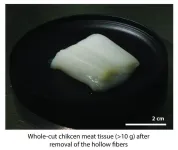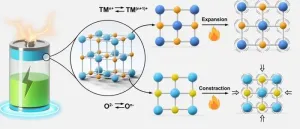(Press-News.org) Switching from diesel to electric trains dramatically improved the air quality aboard the San Francisco Bay Area’s Caltrain commuter rail line, reducing riders’ exposure to the carcinogen black carbon by an average of 89%, finds a new study published today in the journal Environmental Science and Technology Letters.
The electrification of the system also significantly reduced the ambient black carbon concentrations within and around the San Francisco station, the study found.
“The transition from diesel to electric trains occurred over just a few weeks, and yet we saw the same drop in black carbon concentrations in the station as California cities achieved from 30 years of clean air regulations,” said study senior author Joshua Apte, a professor of environmental engineering and environmental health at the University of California, Berkeley. “It really adds to the case for electrifying the many other rail systems in the U.S. that still use old, poorly regulated diesel locomotives.”
Caltrain operates the busiest commuter rail system in the western U.S., carrying millions of passengers a year along its 47-mile route between San Francisco and San Jose. Over the course of six weeks in August and September 2024, the system retired all 29 of its diesel locomotives and replaced them with 23 new electric trains. The debut of the new trains was the culmination of a $2.44 billion modernization and decarbonization project that first launched in 2017.
Apte, an expert in air quality monitoring, was inspired to pursue the study after visiting a Caltrain station in August 2024, when the very first electric trains were being introduced.
“I was stunned at how much the station smelled like diesel smoke and how noisy it was from the racket of diesel locomotives idling away at the platforms, dumping smoke out into the community,” Apte said. “A light bulb went off my head — I realized this would all be going away in a few weeks.”
After securing the support of Caltrain, Apte and study lead author Samuel Cliff quickly mobilized, installing black carbon detectors at Caltrain stations and carrying portable air quality detectors aboard the trains. For four weeks, they tracked the rapid improvements in air quality as old diesel locomotives were replaced by new electric trains.
“A lot of these transitions happen pretty slowly. This one happened in a blink of an eye,” Apte said. “We had the unique opportunity to capture the ancillary public health benefits.”
According to Apte and Cliff’s calculations, the reduction in black carbon exposure achieved from Caltrain’s electrification cut excess cancer deaths by 51 per 1 million people for riders and 330 per 1 million people for train conductors. For reference, the U.S. Environmental Protection Agency has a policy that any exposure that increases the average individual’s cancer risk by more than one per million is considered unacceptable.
“If you think about this in the context of the whole of the U.S., where we have millions of people commuting by rail every day, that's hundreds of cases of cancer that could be prevented each year,” said Cliff, a postdoctoral scholar at UC Berkeley.
The majority of U.S. commuter trains are still powered by diesel fuel, despite the fact that electric trains are quieter, more reliable and produce fewer greenhouse gases than diesel locomotives. Apte hopes the study motivates more U.S. municipalities to follow the lead of Asian and European countries in electrifying their railways.
“This is something that we ought to find a way to do as quickly as possible, everywhere,” Apte said. “California has long-term plans to electrify most of its rail systems, but this shows that we shouldn't be waiting another 25 years to get it done. We should be speeding it up.”
Co-authors of the study include Haley McNamara Byrne and Allen Goldstein of UC Berkeley.
END
Study finds dramatic boost in air quality from electrifying railways
A new study found that electrifying the San Francisco Bay Area’s Caltrain commuter rail line reduced riders’ exposure to black carbon, a carcinogen, by an average of 89%
2025-04-16
ELSE PRESS RELEASES FROM THIS DATE:
Bite-sized chunks of chicken with the texture of whole meat can be grown in the lab
2025-04-16
A bioreactor that mimics a circulatory system can deliver nutrients and oxygen to artificial tissue, enabling the production of over 10 grams of chicken muscle for cultured meat applications. These results are publishing in the Cell Press journal Trends in Biotechnology on April 16.
“Our study presents a scalable, top-down strategy for producing whole-cut cultured meat using a perfusable hollow fiber bioreactor,” says senior author Shoji Takeuchi of The University of Tokyo. “This system enables cell distribution, alignment, contractility, ...
A compact, mid-infrared pulse generator
2025-04-16
Physicists in the Harvard John A. Paulson School of Engineering and Applied Sciences (SEAS) have created a compact laser that emits extremely bright, short pulses of light in a useful but difficult-to-achieve wavelength range, packing the performance of larger photonic devices onto a single chip.
Published in Nature, the research is the first demonstration of an on-chip, picosecond, mid-infrared laser pulse generator that requires no external components to operate. The device can make what’s called an optical frequency comb, a spectrum of light consisting of equally spaced frequency lines (like a comb), used today in precision measurements. ...
Sex-based differences in binge and heavy drinking among US adults
2025-04-16
About The Study: This analysis found that past-month binge drinking among young adult females in 2021-2023 was higher than males, reversing 2017-2019 patterns, whereas males in other age groups continued to binge and heavy drink at higher rates. These findings may be due to more rapid decreases in binge drinking over time among young adult males relative to females, or to plateauing or increases in binge drinking among females. Further investigation using other nationally representative surveys is needed to elucidate these explanations.
Corresponding Author: To contact the corresponding author, Bryant Shuey, MD, MPH, email bryant.shuey@pitt.edu.
To ...
Using vibrations to see into Yellowstone's magma reservoir
2025-04-16
Beneath Yellowstone lies a magma reservoir, pulsing with molten and superheated rock and exsolved gases. Scientists have long known about the chamber’s existence, but have yet to precisely locate its uppermost boundary and characterize the contents of the chamber closest to the surface—information crucial for understanding the potential perils this volcanic feature poses.
That changed this week with new research by seismologists from the University of Utah and the University of New Mexico (UNM) who used hundreds of portable seismometers and a mechanical vibration source to render 2D seismic reflection images of the ground beneath Yellowstone’s caldera.
Using ...
From disorder to order: scientists rejuvenate aging batteries
2025-04-16
A team of scientists led by Prof. LIU Zhaoping at the Ningbo Institute of Materials Technology and Engineering (NIMTE) of the Chinese Academy of Sciences, in collaboration with researchers from the University of Chicago and other institutions, has developed zero thermal expansion (ZTE) materials. This innovation has achieved nearly 100% voltage recovery in aging lithium-ion batteries (LIBs), as detailed in a study published in Nature.
LIBs have become increasingly essential in the markets for electric vehicles and aircraft. Lithium-rich layered oxide cathode materials can deliver record capacities exceeding 300 mAh/g, thanks to revolutionary oxygen-redox (OR) ...
Metabolism shapes life
2025-04-16
New research from Barcelona and Dresden: Glycolysis — the process of converting sugar into energy — plays a key role in early development.
More than fuel: Glycolysis doesn’t just power cells — it helps steer them toward specific tissue types at critical moments in development.
Better embryo models: Stem-cell–based embryo models that rely on glycolysis form structures more similar to natural embryos.
Predict and control development in a dish: These findings improve our ability to predict and control how stem-cell-based embryo models will develop, ...
AI–enabled prediction of heart failure risk from single-lead electrocardiograms
2025-04-16
About The Study: Across multinational cohorts, a noise-adapted artificial intelligence (AI)-electrocardiogram (ECG) model estimated heart failure risk using lead I ECGs, suggesting a potential heart failure risk-stratification strategy requiring prospective study using wearable and portable ECG devices.
Corresponding Author: To contact the corresponding author, Rohan Khera, MD, MS, email rohan.khera@yale.edu.
To access the embargoed study: Visit our For The Media website at this link https://media.jamanetwork.com/
(doi:10.1001/jamacardio.2025.0492)
Editor’s ...
Immediate skin-to-skin contact in very preterm neonates and early childhood neurodevelopment
2025-04-16
About The Study: In this randomized clinical trial, 2 hours of mother-neonate skin-to-skin contact (SSC) in the delivery room did not enhance neurodevelopmental outcomes at 2 to 3 years of age. However, the SSC group demonstrated improved breastfeeding practices up to 12 months compared with standard care, suggesting that the feasible and low-cost SSC intervention should be encouraged in clinical practice.
Corresponding Author: To contact the corresponding author, Laila Kristoffersen, RN, PhD, email laila.kristoffersen@ntnu.no.
To ...
‘Cosmic radio’ could find dark matter in 15 years
2025-04-16
Scientists have designed a ‘cosmic radio’ detector which could discover dark matter in 15 years.
Published today in Nature, scientists at King’s College London, Harvard University, UC Berkley and others have shared the foundation of what they believe will be the most accurate dark matter detector to date.
Dark matter is the unobservable form of matter could make up as much as 85% of mass in the Universe, but scientists are not sure exactly what it is.
Axions are one of the leading ...
Supercharged mitochondria spark aging-related blood disorders
2025-04-16
As we age, blood stem cells, the essential source of new blood cells in the body, can accumulate genetic mutations. These mutations can give the cells a growth advantage, laying the foundation for developing serious health conditions. Now, scientists at The Jackson Laboratory (JAX) have not only discovered the mechanism that fuels their unchecked growth but have also found a way to stop it.
Led by Jennifer Trowbridge, professor and The Dattels Family Chair at JAX, the study reported today in the April 16 issue of Nature Communications reveals that a common aging-associated mutation in the gene Dnmt3a boosts the power-generating function of mitochondria ...
LAST 30 PRESS RELEASES:
New study overturns long-held model of how plants coordinate immune responses.
New AI model predicts disease risk while you sleep
Scientists discover molecular ‘reshuffle’ and crack an 80-year-old conundrum
How stressors during pregnancy impact the developing fetal brain
Electrons lag behind the nucleus
From fungi to brain cells: one scientist's winding path reveals how epigenomics shapes neural destiny
Schizophrenia and osteoporosis share 195 genetic loci, highlighting unexpected biological bridges between brain and bone
Schizophrenia-linked genetic variant renders key brain receptor completely unresponsive to both natural and therapeutic compounds
Innovative review reveals overlooked complexity in cellular energy sensor's dual roles in Alzheimer's disease
Autism research reframed: Why heterogeneity is the data, not the noise
Brazil's genetic treasure trove: supercentenarians reveal secrets of extreme human longevity
The (metabolic) cost of life
CFRI special issue call for papers: New Frontiers in Sustainable Finance
HKU Engineering scholar demonstrates the smallest all-printed infrared photodetectors to date
Precision empowerment for brain "eavesdropping": CAS team develops triple-electrode integrated functional electrode for simultaneous monitoring of neural signals and chemical transmitters during sleep
Single-capillary endothelial dysfunction resolved by optoacoustic mesoscopy
HKU three research projects named among ‘Top 10 Innovation & Technology News in Hong Kong 2025’ showcasing excellence in research and technology transfer
NLRSeek: A reannotation-based pipeline for mining missing NLR genes in sequenced genomes
A strand and whole genome duplication–aware collinear gene identification tool
Light storage in light cages: A revolutionary approach to on-chip quantum memories
Point spread function decoupling in computational fluorescence microscopy
BacPhase: Long-insert paired-end sequencing for bin marker construction and genome phasing
GmWOX1 regulates the mediolateral polarity of compound leaves in soybean
ChargeFabrica: An open-source simulation tool that aims to accelerate search for high performance perovskite solar cells
High levels of ADAR overexpression induce abundant and stochastic off-target RNA editing in rice protoplasts
On-demand upgraded recycling of polyethylene and construction of sustainable multifunctional materials based on the "LEGO" strategy
New "Stomata in-sight" system allows scientists to watch plants breathe in real-time
Anorexia nervosa may result in long-term skeletal muscle impairment
Narrative-based performance reviews deemed fairest by employees
New insights reveal how advanced oxidation can tackle emerging water pollutants
[Press-News.org] Study finds dramatic boost in air quality from electrifying railwaysA new study found that electrifying the San Francisco Bay Area’s Caltrain commuter rail line reduced riders’ exposure to black carbon, a carcinogen, by an average of 89%








